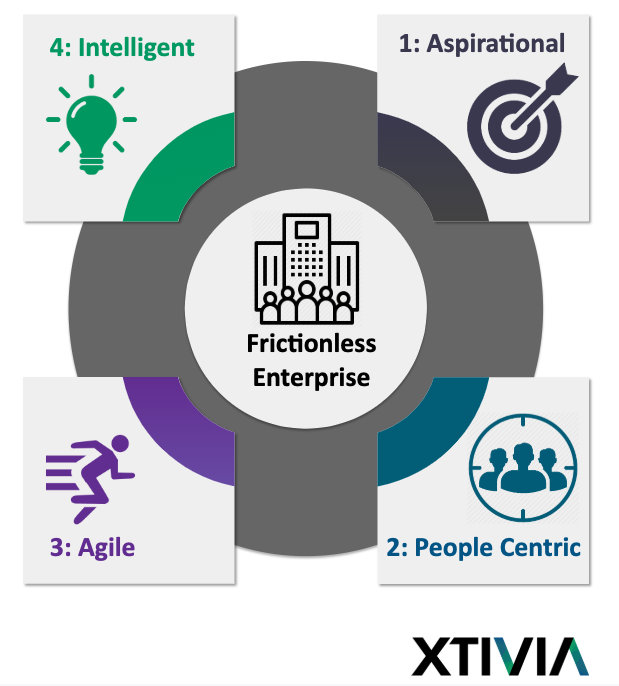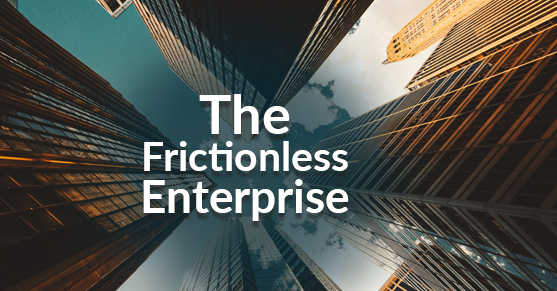Whether it’s on your favorite social media platform or mentioned in the latest Gartner/Forrester analyst reports, you cannot escape conversations about digital transformation, customer experience and eliminating friction. As with most emerging trends, these concepts are going through their own hype cycle, which is not too different from the Gartner Hype Cycle that applies to emerging technologies and applications. Depending on the industry, digital transformation has either reached the “Plateau of Productivity” or is advancing through the “Slope of Enlightenment.”
Enterprises are facing new expectations from their customers. As I wrote in a post from a few months ago, customers are savvier than ever and expect their brand experiences to match their last best experience. Additionally, they are faced with new challenges from their competitors, some of whom did not even exist until recently. The need of the hour for enterprises today is to reinvent themselves and become as frictionless as possible in their customer experience, whether the customer is external or internal.
Enter the frictionless enterprise. I posit that the frictionless enterprise is the foundation of a truly successful digital transformation initiative.
Defining The Frictionless Enterprise
Like all other aspects of business today, enterprises must streamline and improve the delivery of digital experience by being as frictionless as possible. In the enterprise, friction appears as fragmented customer profiles, departmental silos, inefficient workflows, shadow IT, slow feature deployment, a disparate martech stack, redundant processes and anything else that gets in the way of or slows customer and user experience. This friction extends beyond just internal operations to any and all interactions with customers, partners, suppliers and all interested stakeholders.
Therefore, the definition of frictionless is the ability to deliver relevant information and solutions that help accomplish desired outcomes in a timely, cost-effective, streamlined way.
Designing The Frictionless Enterprise
Designing a frictionless enterprise is more than digitizing all operations in their current forms; instead, it is about eradicating institutionalized friction from “the way it’s always been done” to developing and innovating what will work best for your customers, users and enterprise goals today. This can mean reassigning staff responsibilities, reallocating resources, upgrading aging systems, migrating IT operations to the cloud, reevaluating partner relationships, researching new suppliers, attracting a new type of customer, finding new applications for your solutions in the marketplace and more. The target result is to meet your customers and users in their context and reduce their effort in getting what they want from your organization.
Historically, factors that caused friction included time, distance and lack of information; today, these factors are resolved. Now the factors that cause friction include maintaining the status quo, having a corporate culture that does not support innovation, dated business models, lacking real-time data and business intelligence, and/or disparate, aging IT architecture. The good news is that these, too, will be resolved through intentional design and focused action.
The Four Traits Of Frictionless Enterprise
Of the many factors that go into a frictionless enterprise, there are just four traits that ultimately define it:

1. Aspirational:
Growth can only happen where it is expected and encouraged. For an organization to become a frictionless enterprise, monumental change is needed — the kind of change that gives pause to even the hardiest executive leadership teams. This change can only happen if leaders espouse and practice an aspirational culture that, on the surface, borders on being unreasonable. Being “unreasonable” is necessary to jolt an organization out of the status quo and to think big.
Your corporate culture must be about reinventing the business even if it is disruptive to your own products and services and be open to eliminating potential sources of friction and constraint. Continuous improvement must be valued, disruption welcomed, mistakes expected (and forgiven) and progress celebrated. Becoming frictionless is as much about the journey as about the goal; the yardstick for measuring frictionless will keep moving away even though you eliminate friction in leaps and bounds.
2. People-centric:
The only reason a business succeeds is because of and for people, and that is not limited to the customer or user experience. Revisit every aspect of your enterprise brand, operations, skills and workflows to improve on delivering a more delightful, intuitive and empathic experience. Focus on delivering more value to your people so your company will be sustainable.
3. Agile:
Agility comes in many forms, including the ability to change a business direction, having systems and processes that enable change, capturing and applying real-time data about your customers and marketplace, individuals who are early adopters of change, and, perhaps most importantly, leaders who can problem-solve and make decisions with speed. In fact, Jeff Bezos indicatesAmazon’s “Day 1” philosophy of agility, where powerful trends are embraced quickly, as a key factor in Amazon’s success.
4. Intelligent:
Enterprises today are gatheringvast amounts of data from their business operations, including:
- Data about their external and internal customers.
- Data about their products, services, and offerings.
- Data about their customers’ interactions with the enterprise, whether that is browsing information on the company website, transactions on the customer portal or help desk calls/tickets/chats.
- Data about how customers use their products and services, including through connected devices.
- Data from third-party data sources.
Data collection on this scale, and the actionable insights offered by this collected data, represent a huge opportunity for the frictionless enterprise to do more with less. Processes will be automated, employees will be empowered to help customers (and each other), business models will be upgraded, data assets will be leveraged to achieve results faster and it will all happen with less potential risk.
Mastering the four traits of a frictionless enterprise will enable you to take your organization’s game to the next level.
The Bottom Line
Design your enterprise to be frictionless by analyzing every department, system, workflow, technology and asset for alignment with your corporate culture, people-centricity, agility, and intelligence. Challenge yourself to excel at not just one or two of the frictionless enterprise traits but all of them, as they will be foundational to your frictionless journey.
This post was originally published for Forbes Tech Council

